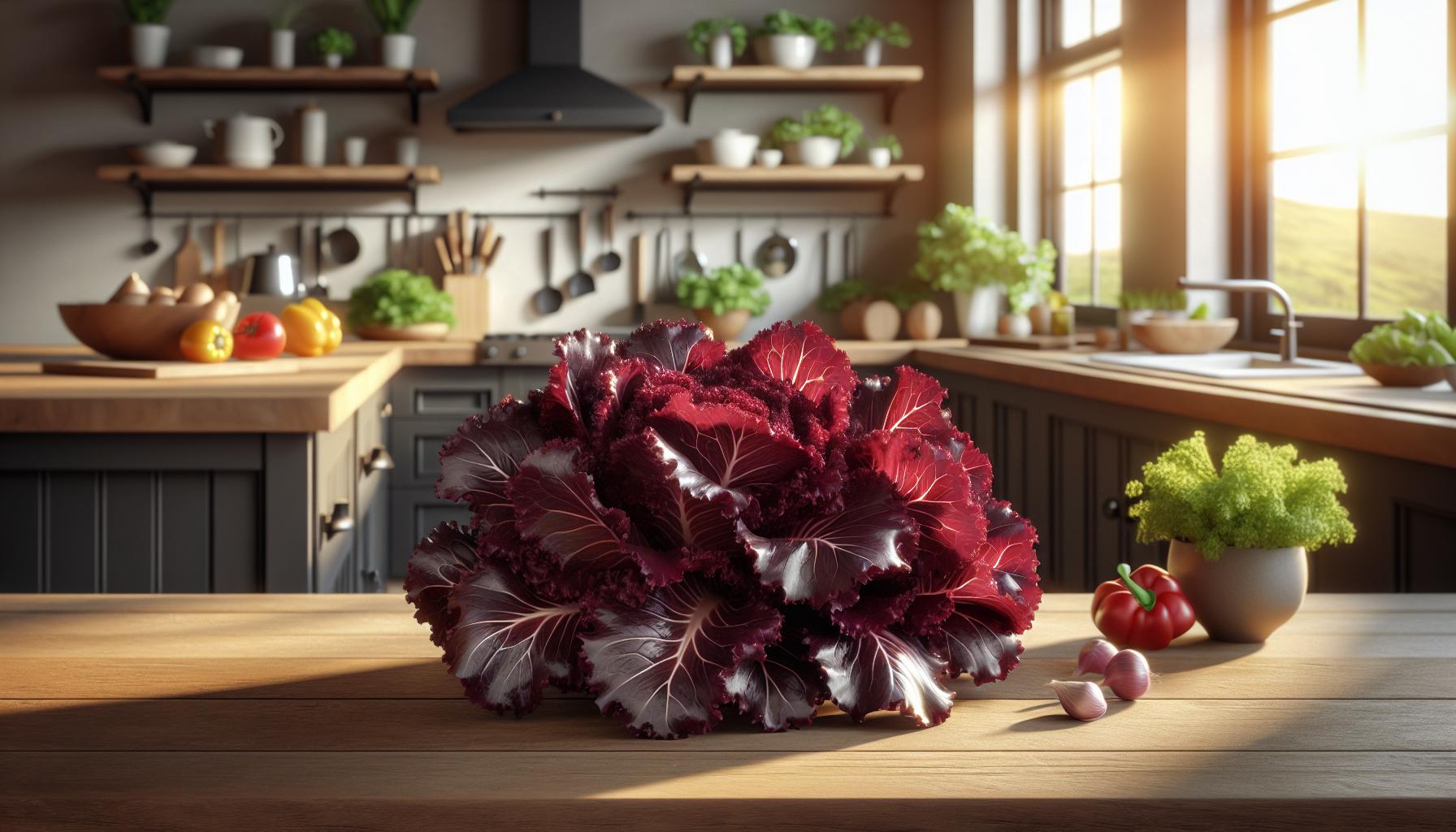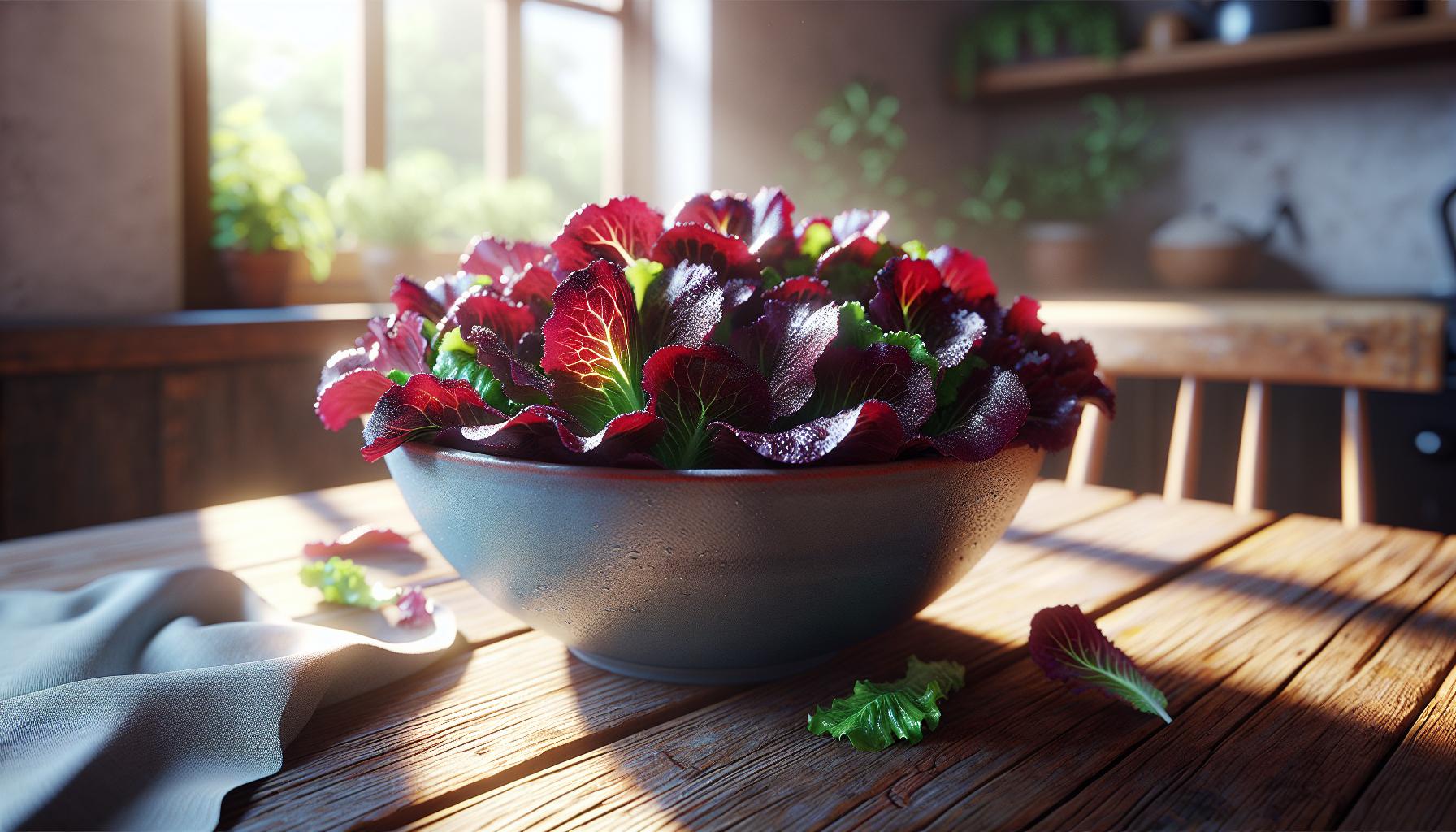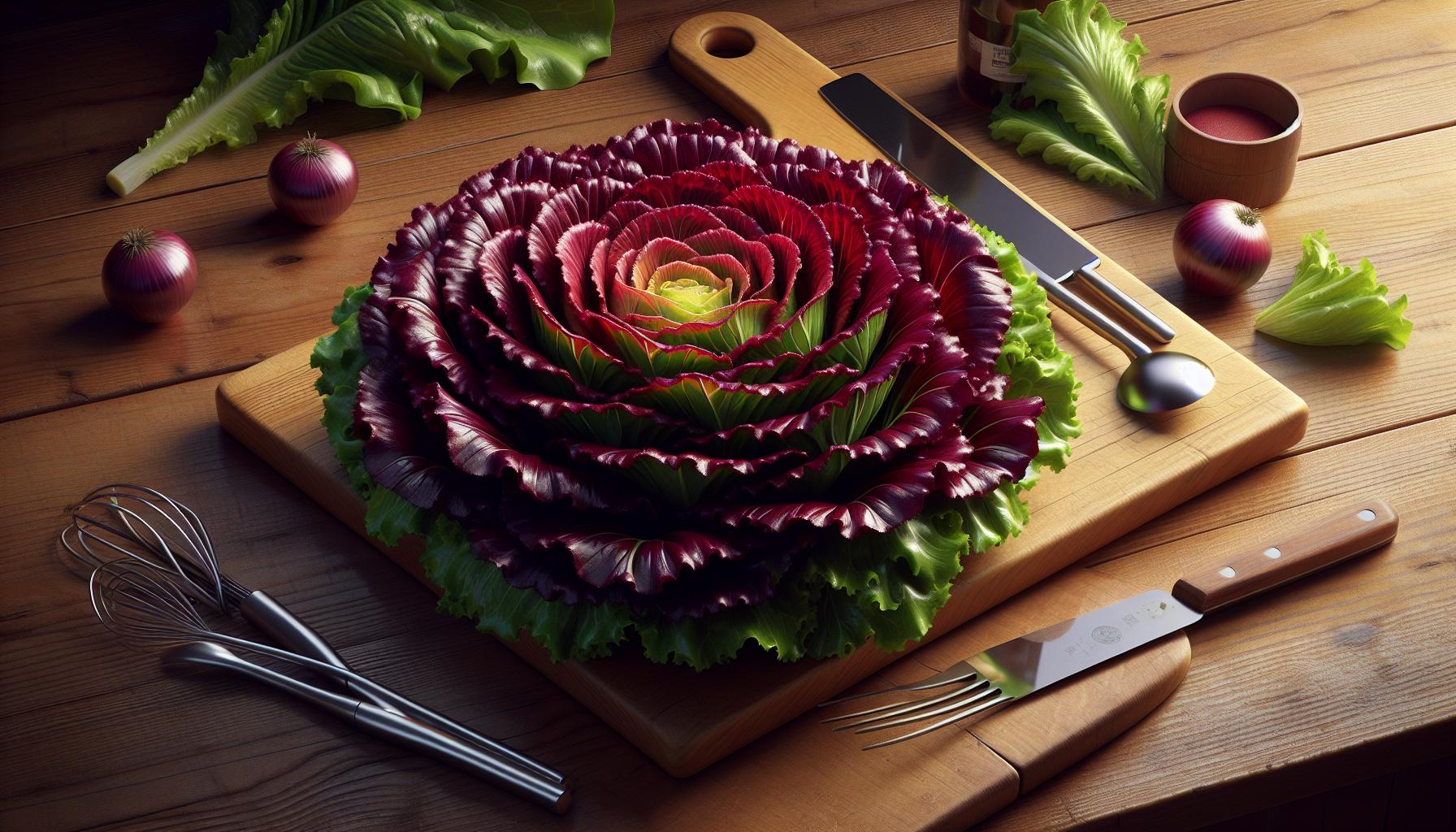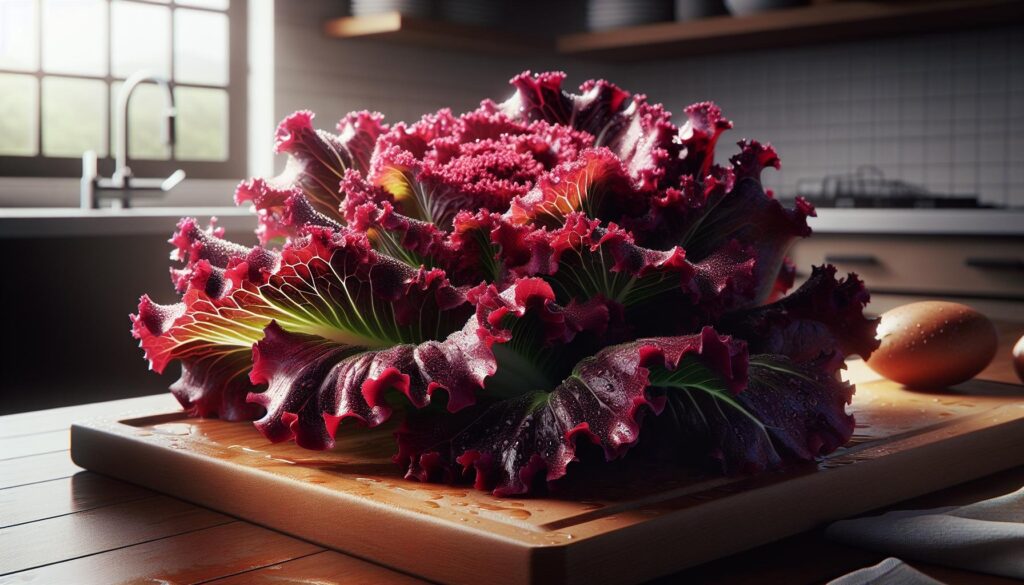Red leaf lettuce brings a pop of color and nutritional punch to any meal. This vibrant leafy green doesn’t just look pretty on the plate – it’s packed with essential vitamins minerals and antioxidants that support overall health. With its distinctive burgundy hue and delicate texture it’s become a favorite among health-conscious food lovers and culinary enthusiasts alike.
Beyond its aesthetic appeal red leaf lettuce offers an impressive nutritional profile that rivals its green counterparts. It’s low in calories yet rich in vitamins A and K making it an excellent choice for those looking to maintain a balanced diet without sacrificing flavor. Whether tossed in a fresh salad layered in sandwiches or used as a colorful garnish this versatile vegetable proves that eating healthy doesn’t have to be boring.
Red Leaf Lettuce Nutrition
Red leaf lettuce features loosely packed, burgundy-tinted leaves with ruffled edges attached to a center stalk. The leaves graduate from deep red at the tips to green at the base, creating a distinctive ombre effect.
This leafy vegetable belongs to the Asteraceae family alongside other lettuce varieties like romaine butter lettuce. The plant grows in loose heads measuring 6 to 12 inches across, with individual leaves spanning 3 to 6 inches in length.
The texture profile includes:
- Tender outer leaves with a delicate crunch
- Soft inner leaves with a buttery feel
- Crisp leaf ribs providing structural support
Its flavor characteristics encompass:
- Mild sweetness
- Subtle nutty undertones
- Light peppery notes
- Gentle bitter finish
Growing conditions affect red leaf lettuce development:
- Cool weather temperatures (60-65°F)
- Well-drained soil
- Partial to full sunlight
- 45-55 days to maturity
The red pigmentation comes from anthocyanins, the same compounds found in red wine grapes berries. These plant compounds serve as powerful antioxidants while giving the leaves their distinctive coloring.
| Storage Method | Temperature | Duration |
|---|---|---|
| Refrigerator | 35-40°F | 7-10 days |
| Crisper drawer | 35-40°F | 5-7 days |
| Room temp | 68-72°F | 1-2 days |
Nutritional Profile of Red Leaf Lettuce

Red leaf lettuce contains essential nutrients while maintaining a low caloric content of 13 calories per 100-gram serving. Its diverse nutritional composition makes it an excellent addition to a balanced diet.
Vitamins and Minerals
Red leaf lettuce delivers high concentrations of vitamin K, providing 140% of the daily value in one cup. Vitamin A content reaches 127% of the daily value per serving, supporting eye health through beta-carotene. The lettuce contains significant amounts of vitamin C at 11% of the daily value per cup. Essential minerals include potassium (187mg per 100g), calcium (33mg per 100g), and iron (1.2mg per 100g).
| Nutrient | Amount per 100g | Daily Value % |
|---|---|---|
| Vitamin K | 140mcg | 140% |
| Vitamin A | 7492 IU | 127% |
| Vitamin C | 9.2mg | 11% |
| Potassium | 187mg | 5% |
Antioxidants and Phytonutrients
Red leaf lettuce contains anthocyanins, giving its leaves their distinctive burgundy color. These compounds act as powerful antioxidants, protecting cells from oxidative stress. The lettuce provides quercetin, a flavonoid that exhibits anti-inflammatory properties. Lutein and zeaxanthin concentrate in the leaves, supporting ocular health. Polyphenols present in red leaf lettuce contribute to its antioxidant capacity, with higher concentrations found in the darker portions of the leaves.
| Antioxidant Type | Benefits |
|---|---|
| Anthocyanins | Cell protection, anti-inflammatory |
| Quercetin | Anti-inflammatory, immune support |
| Lutein/Zeaxanthin | Eye health, UV protection |
Health Benefits of Red Leaf Lettuce

Red leaf lettuce offers numerous health advantages through its rich nutrient profile. The combination of vitamins, minerals, and antioxidants in red leaf lettuce supports multiple bodily functions.
Heart Health Benefits
Red leaf lettuce contains potassium which helps regulate blood pressure levels by counteracting the effects of sodium. The high vitamin K content supports proper blood clotting and promotes arterial health. A 100-gram serving provides:
| Nutrient | Benefit to Heart Health |
|---|---|
| Potassium | Reduces blood pressure |
| Vitamin K | Supports arterial function |
| Nitrates | Improves blood flow |
The nitrates in red leaf lettuce convert to nitric oxide in the body, helping blood vessels dilate. Regular consumption correlates with improved cardiovascular function and reduced risk of heart disease.
Anti-Inflammatory Properties
Red leaf lettuce contains anthocyanins that reduce inflammation throughout the body. These compounds target inflammatory markers linked to chronic diseases. The antioxidants present include:
| Antioxidant | Anti-Inflammatory Action |
|---|---|
| Anthocyanins | Reduces oxidative stress |
| Quercetin | Suppresses inflammatory compounds |
| Vitamin C | Neutralizes free radicals |
Studies show these compounds work synergistically to decrease inflammation markers in blood tests. The combination of these nutrients provides protection against cellular damage caused by environmental stressors.
How to Select and Store Red Leaf Lettuce

Selecting Fresh Red Leaf Lettuce
Fresh red leaf lettuce displays vibrant burgundy coloring on the outer leaves with green centers. The leaves stay crisp with no signs of wilting or browning. Healthy specimens feature firm stems without dark spots. The head feels relatively heavy for its size when lifted.
Storage Methods
Proper storage begins with gentle washing in cold water to remove debris. A salad spinner removes excess moisture from the leaves. Store unwashed leaves wrapped in paper towels inside a plastic bag with small air holes. Place the sealed bag in the crisper drawer of the refrigerator at 40°F (4°C).
Storage Duration and Signs of Spoilage
- Browning edges on leaves
- Slimy texture development
- Wilted or limp leaves
- Strong unpleasant odors
- Dark spots on stems or leaves
- Remove damaged outer leaves before storage
- Keep lettuce away from ethylene producing fruits like apples bananas
- Maintain consistent refrigerator temperature
- Check stored lettuce every 3 days for quality
- Use clean storage containers or bags
| Storage Method | Duration | Temperature |
|---|---|---|
| Refrigerated (unwashed) | 7-10 days | 40°F (4°C) |
| Refrigerated (washed) | 3-5 days | 40°F (4°C) |
| Room temperature | 1-2 days | 68°F (20°C) |
Ways to Include Red Leaf Lettuce in Your Diet
Red leaf lettuce transforms everyday dishes into vibrant culinary creations with minimal effort. Here are practical ways to incorporate this nutritious green:
Salad Combinations
- Mix with quinoa, sliced almonds, dried cranberries for a protein-rich meal
- Toss with grilled chicken, mandarin oranges, walnuts for a complete lunch
- Combine with roasted beets, goat cheese, pine nuts for an elegant starter
Sandwich Enhancements
- Layer between whole grain bread with avocado, tomato slices
- Add to wraps with hummus, cucumber, bell peppers
- Place inside pita pockets with falafel, tahini sauce
Cooking Applications
- Sauté briefly with garlic, olive oil for a warm side dish
- Stir into hot soups just before serving for added nutrition
- Steam lightly to create a bed for grilled fish or chicken
Creative Uses
- Roll into spring rolls with rice noodles, carrots, mint
- Blend into green smoothies with apple, cucumber, ginger
- Use as a natural food wrap alternative for low-carb options
- Top pizzas after baking for fresh crunch
- Garnish grain bowls with torn leaves
- Add to tacos or burritos for extra color texture
Each serving (2 cups) provides essential nutrients while adding only 13 calories to meals. Store prepared combinations in airtight containers separately from dressings to maintain freshness for 3 days.
Conclusion
Red leaf lettuce stands out as a nutritional powerhouse that’s both versatile and delicious. Its impressive array of vitamins minerals and antioxidants make it an excellent choice for health-conscious individuals. The combination of its vibrant appearance crisp texture and mild flavor profile ensures it’s more than just a nutritious addition to meals – it’s a culinary delight.
Whether enjoyed fresh in salads layered in sandwiches or incorporated into cooked dishes red leaf lettuce offers a simple yet effective way to enhance both the nutritional value and visual appeal of meals. With proper storage and handling this nutrient-rich leafy green can be a regular part of a healthy balanced diet.

